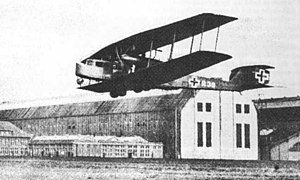Zeppelin-Staaken R.VI
| Zeppelin-Staaken R.VI | |
|---|---|
 |
|
| Role | Bomber |
| Manufacturer | Zeppelin-Staaken |
| Designer | Alexander Baumann |
| First flight | 1916 |
| Primary user | Luftstreitkräfte |
| Produced | 1917 to 1919 |
| Number built | 18 |
| Variants | Zeppelin-Staaken R.V, Zeppelin-Staaken R.VII, Zeppelin-Staaken R.XIV, Zeppelin-Staaken R.XV, Zeppelin-Staaken R.XVI |
The Zeppelin-Staaken R.VI was a four-engined German biplane strategic bomber of World War I, and the only Riesenflugzeug ("giant aircraft") design built in any quantity.
The R.VI was the most numerous of the R-bombers built by Germany, and also among the earliest closed-cockpit military aircraft (the first being the Russian Sikorsky Ilya Muromets). The bomber was reputedly the largest wooden aircraft to be produced in any quantity during World War I, with only the Siemens-Schuckert R.VIII prototype bomber of 1918–1919 being larger, with the Staaken R.VI's wingspan of 42.2 m (138 ft) nearly equaling that of the World War II Boeing B-29 Superfortress, and somewhat less than the 48 m (157 ft) span of the Siemens-Schuckert R.VIII.
In September 1914, at the start of World War I, Ferdinand von Zeppelin visualised the concept of a Riesenflugzeug (R) bomber, to be larger than the then-nascent Friedel-Ursinus twin-engined military aircraft. Using engineers from the Robert Bosch GmbH, he created the Versuchsbau Gotha-Ost (VGO) consortium in a rented hangar at the Gotha factory. Alexander Baumann became his chief engineer, although later the team included other noted engineers including Zeppelin's associate Claudius Dornier, the 1915 pioneer of all-metal aircraft construction in Hugo Junkers and Baumann's protogé Adolph Rohrbach. Almost all of these Zeppelin-Staaken Riesenflugzeug designs used some variation of either pusher configuration and/or push-pull configuration in their engine layout, orientation and placement of their powerplants.
...
Wikipedia
